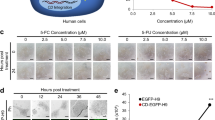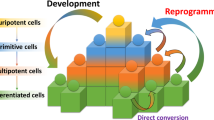Abstract
Reprogramming of somatic cells to pluripotency, thereby creating induced pluripotent stem (iPS) cells, promises to transform regenerative medicine. Most instances of direct reprogramming have been achieved by forced expression of defined factors using multiple viral vectors1,2,3,4,5,6,7. However, such iPS cells contain a large number of viral vector integrations1,8, any one of which could cause unpredictable genetic dysfunction. Whereas c-Myc is dispensable for reprogramming9,10, complete elimination of the other exogenous factors is also desired because ectopic expression of either Oct4 (also known as Pou5f1) or Klf4 can induce dysplasia11,12. Two transient transfection-reprogramming methods have been published to address this issue13,14. However, the efficiency of both approaches is extremely low, and neither has been applied successfully to human cells so far. Here we show that non-viral transfection of a single multiprotein expression vector, which comprises the coding sequences of c-Myc, Klf4, Oct4 and Sox2 linked with 2A peptides, can reprogram both mouse and human fibroblasts. Moreover, the transgene can be removed once reprogramming has been achieved. iPS cells produced with this non-viral vector show robust expression of pluripotency markers, indicating a reprogrammed state confirmed functionally by in vitro differentiation assays and formation of adult chimaeric mice. When the single-vector reprogramming system was combined with a piggyBac transposon15,16, we succeeded in establishing reprogrammed human cell lines from embryonic fibroblasts with robust expression of pluripotency markers. This system minimizes genome modification in iPS cells and enables complete elimination of exogenous reprogramming factors, efficiently providing iPS cells that are applicable to regenerative medicine, drug screening and the establishment of disease models.
This is a preview of subscription content, access via your institution
Access options
Subscribe to this journal
Receive 51 print issues and online access
$199.00 per year
only $3.90 per issue
Buy this article
- Purchase on Springer Link
- Instant access to full article PDF
Prices may be subject to local taxes which are calculated during checkout



Similar content being viewed by others
References
Takahashi, K. & Yamanaka, S. Induction of pluripotent stem cells from mouse embryonic and adult fibroblast cultures by defined factors. Cell 126, 663–676 (2006)
Wernig, M. et al. In vitro reprogramming of fibroblasts into a pluripotent ES-cell-like state. Nature 448, 318–324 (2007)
Maherali, N. et al. Directly reprogrammed fibroblasts show global epigenetic remodeling and widespread tissue contribution. Cell Stem Cell 1, 55–70 (2007)
Takahashi, K. et al. Induction of pluripotent stem cells from adult human fibroblasts by defined factors. Cell 131, 861–872 (2007)
Yu, J. et al. Induced pluripotent stem cell lines derived from human somatic cells. Science 318, 1917–1920 (2007)
Park, I. H. et al. Reprogramming of human somatic cells to pluripotency with defined factors. Nature 451, 141–146 (2008)
Okita, K., Ichisaka, T. & Yamanaka, S. Generation of germline-competent induced pluripotent stem cells. Nature 448, 313–317 (2007)
Aoi, T. et al. Generation of pluripotent stem cells from adult mouse liver and stomach cells. Science 321, 699–702 (2008)
Nakagawa, M. et al. Generation of induced pluripotent stem cells without Myc from mouse and human fibroblasts. Nature Biotechnol. 26, 101–106 (2008)
Wernig, M., Meissner, A., Cassady, J. P. & Jaenisch, R. c-Myc is dispensable for direct reprogramming of mouse fibroblasts. Cell Stem Cell 2, 10–12 (2008)
Hochedlinger, K., Yamada, Y., Beard, C. & Jaenisch, R. Ectopic expression of Oct-4 blocks progenitor-cell differentiation and causes dysplasia in epithelial tissues. Cell 121, 465–477 (2005)
Foster, K. W. et al. Induction of KLF4 in basal keratinocytes blocks the proliferation–differentiation switch and initiates squamous epithelial dysplasia. Oncogene 24, 1491–1500 (2005)
Stadtfeld, M., Nagaya, M., Utikal, J., Weir, G. & Hochedlinger, K. Induced pluripotent stem cells generated without viral integration. Science 322, 954–959 (2008)
Okita, K., Nakagawa, M., Hyenjong, H., Ichisaka, T. & Yamanaka, S. Generation of mouse induced pluripotent stem cells without viral vectors. Science 322, 949–953 (2008)
Wang, W. et al. Chromosomal transposition of PiggyBac in mouse embryonic stem cells. Proc. Natl Acad. Sci. USA 105, 9290–9295 (2008)
Woltjen, K. et al. piggyBac transposition reprograms fibroblasts to induced pluripotent stem cells. Nature 10.1038/nature07863 (this issue)
Hasegawa, K., Cowan, A. B., Nakatsuji, N. & Suemori, H. Efficient multicistronic expression of a transgene in human embryonic stem cells. Stem Cells 25, 1707–1712 (2007)
Szymczak, A. L. et al. Correction of multi-gene deficiency in vivo using a single ‘self-cleaving’ 2A peptide-based retroviral vector. Nature Biotechnol. 22, 589–594 (2004)
Sommer, C. A. et al. iPS cell generation using a single lentiviral stem cell cassette. Stem Cells 10.1634/stemcells.2008–1075 (2008)
Carey, B. W. et al. Reprogramming of murine and human somatic cells using a single polycistronic vector. Proc. Natl Acad. Sci. USA 106, 157–162 (2009)
Niwa, H., Yamamura, K. & Miyazaki, J. Efficient selection for high-expression transfectants with a novel eukaryotic vector. Gene 108, 193–199 (1991)
Yeh, E. et al. A signalling pathway controlling c-Myc degradation that impacts oncogenic transformation of human cells. Nature Cell Biol. 6, 308–318 (2004)
Chambers, I. et al. Nanog safeguards pluripotency and mediates germline development. Nature 450, 1230–1234 (2007)
Mikkelsen, T. S. et al. Dissecting direct reprogramming through integrative genomic analysis. Nature 454, 49–55 (2008)
Kunath, T. et al. FGF stimulation of the Erk1/2 signalling cascade triggers transition of pluripotent embryonic stem cells from self-renewal to lineage commitment. Development 134, 2895–2902 (2007)
Kaji, K. et al. The NuRD component Mbd3 is required for pluripotency of embryonic stem cells. Nature Cell Biol. 8, 285–292 (2006)
Ying, Q. L., Stavridis, M., Griffiths, D., Li, M. & Smith, A. Conversion of embryonic stem cells into neuroectodermal precursors in adherent monoculture. Nature Biotechnol. 21, 183–186 (2003)
Brueckner, B., Kuck, D. & Lyko, F. DNA methyltransferase inhibitors for cancer therapy. Cancer J. 13, 17–22 (2007)
Acknowledgements
We thank A. Tsakiridis for advice on using the 2A peptide sequence and A. Nagy for providing data from his laboratory on generating human reprogrammed cell lines by combining the PB transposon system and the 2A-sequence-joined reprogramming factors (or MKOS single vector reprogramming system) as well as for his comments on the manuscript. We also thank I. Chambers for providing TNG MEFs and for discussion and comments on the manuscript, V. Wilson for advice on teratoma analysis, T. Kunath, S. Lowell, C. Blackburn and K. Vintersten for discussions and comments on the manuscript, and B. Hendrich for permission to start preliminary experiments of this work in his laboratory. We also thank J. Ure, L. Robertson, R. McLay and R. Wilkie for technical assistance, and Biomed unit staff for mouse husbandry. K.K. is the recipient of MRC career development fellowship in stem cell research. A.P. is the recipient of a BBSRC CASE PhD studentship. M.M., P.M. and K.W. were supported by grants from the Canadian Stem Cell Network and Juvenile Diabetes Research Foundation.
Author Contributions K.K. conceived the study, designed and executed the experiments, interpreted data and wrote the manuscript. K.N. performed immunoblotting and karyotype checking, and assisted with manuscript preparation. A.P. performed real-time PCR and in vitro differentiation experiments. M.M. generated human reprogrammed cells. P.M. performed immunostaining for human reprogrammed cells. K.W. constructed the PB/MKOS system, assisted human cell reprogramming experiments and analysis, and helped to prepare the manuscript.
Author information
Authors and Affiliations
Corresponding author
Supplementary information
Supplementary Information
This file contains Supplementary Figures 1-10 with Legends, Supplementary Tables 1-5 and Supplementary Methods (PDF 4717 kb)
Rights and permissions
About this article
Cite this article
Kaji, K., Norrby, K., Paca, A. et al. Virus-free induction of pluripotency and subsequent excision of reprogramming factors. Nature 458, 771–775 (2009). https://doi.org/10.1038/nature07864
Received:
Accepted:
Published:
Issue Date:
DOI: https://doi.org/10.1038/nature07864
This article is cited by
-
Induced pluripotent stem cells: ex vivo models for human diseases due to mitochondrial DNA mutations
Journal of Biomedical Science (2023)
-
Combination of melt-electrospun poly-ε-caprolactone scaffolds and hepatocyte-like cells from footprint-free hiPSCs to create 3D biohybrid constructs for liver tissue engineering
Scientific Reports (2023)
-
B1 SINE-binding ZFP266 impedes mouse iPSC generation through suppression of chromatin opening mediated by reprogramming factors
Nature Communications (2023)
-
Stem Cell Therapies for Restorative Treatments of Central Nervous System Ischemia–Reperfusion Injury
Cellular and Molecular Neurobiology (2023)
-
Identification of Optimal Expression Parameters and Purification of a Codon-Optimized Human GLIS1 Transcription Factor from Escherichia coli
Molecular Biotechnology (2022)
Comments
By submitting a comment you agree to abide by our Terms and Community Guidelines. If you find something abusive or that does not comply with our terms or guidelines please flag it as inappropriate.



